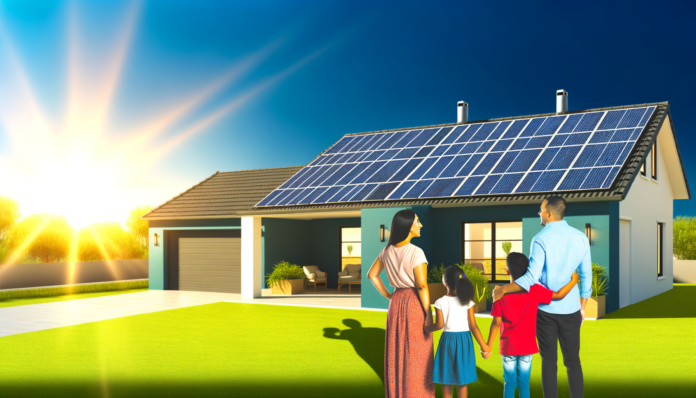Introduction to Solar Energy
The Rise of Solar Power
In recent years, solar power has experienced a meteoric rise, becoming one of the most promising sources of renewable energy. This growth is driven by a combination of technological advancements, decreasing costs, and increasing awareness of environmental issues. According to the International Energy Agency (IEA), solar power is now the cheapest electricity in history, with costs having dropped by 89% over the past decade. This affordability, coupled with the urgent need to reduce carbon emissions, has led to a surge in solar installations worldwide.
Governments and private sectors alike are investing heavily in solar infrastructure. For instance, the United States has seen a significant increase in solar capacity, with the Solar Energy Industries Association (SEIA) reporting that solar accounted for 43% of all new electricity-generating capacity added in the first half of 2021. Similarly, countries like China and India are leading the charge in solar adoption, aiming to meet their ambitious renewable energy targets.
Why Go Solar?
The decision to go solar is driven by a multitude of compelling reasons. Firstly, solar energy is a clean and sustainable source of power. Unlike fossil fuels, solar power generates electricity without emitting greenhouse gases, making it a crucial tool in combating climate change. By installing solar panels, homeowners and businesses can significantly reduce their carbon footprint.
Secondly, solar energy offers substantial financial benefits. With the cost of solar panels decreasing and various financial incentives available, the return on investment (ROI) for solar installations has become increasingly attractive. Homeowners can save on their electricity bills, and in some cases, even earn money by selling excess power back to the grid through net metering programs.
Moreover, solar energy provides energy independence. By generating their own electricity, individuals and businesses can reduce their reliance on utility companies and protect themselves against rising energy costs. This is particularly beneficial in regions prone to power outages or where electricity prices are high.
Understanding Solar Technology
To fully appreciate the benefits of solar energy, it’s essential to understand the technology behind it. Solar power systems primarily consist of solar panels, inverters, and mounting equipment.
**Solar Panels:** These are the most visible component of a solar power system. Made up of photovoltaic (PV) cells, solar panels convert sunlight into direct current (DC) electricity. The efficiency of these panels has improved significantly over the years, with modern panels capable of converting around 20% of sunlight into usable electricity.
**Inverters:** The electricity generated by solar panels is in DC form, which is not suitable for most household appliances. Inverters convert this DC electricity into alternating current (AC) electricity, which can be used to power homes and businesses. There are different types of inverters, including string inverters, microinverters, and power optimizers, each with its own advantages.
**Mounting Equipment:** Solar panels need to be securely mounted on rooftops or ground structures. The mounting system ensures that panels are positioned at the optimal angle to capture maximum sunlight. Advanced tracking systems can even adjust the angle of the panels throughout the day to follow the sun’s path, further increasing efficiency.
In addition to these core components, modern solar systems often include battery storage solutions. Batteries store excess electricity generated during the day for use at night or during cloudy periods, enhancing the reliability and flexibility of solar power.
In conclusion, the rise of solar power is a testament to its viability as a sustainable and cost-effective energy solution. By understanding the technology and the myriad benefits it offers, individuals and businesses can make informed decisions about investing in solar energy.
Financial Incentives for Solar Investment
Federal Tax Credits
The federal government offers a significant incentive for those investing in solar energy through the **Investment Tax Credit (ITC)**. This credit allows homeowners and businesses to deduct 30% of the cost of installing a solar energy system from their federal taxes. This incentive is available for both residential and commercial solar installations and is a substantial financial benefit that can significantly reduce the upfront cost of solar projects.
For example, if your solar installation costs $20,000, you can claim a $6,000 credit on your federal tax return. This credit applies to the total cost of the system, including equipment and installation. The ITC is set to remain at 30% for systems installed by December 31, 2032, after which it will decrease unless Congress renews it.
State and Local Rebates
In addition to federal tax credits, many states and local governments offer rebates and incentives to encourage solar adoption. These incentives can vary widely depending on your location but can significantly reduce the cost of your solar installation.
For instance, some states offer **cash rebates** for solar installations, which can be applied directly to the cost of the system. These rebates can range from a few hundred to several thousand dollars. Additionally, some states provide **property tax exemptions** for the added value that solar panels bring to your home, ensuring that your property taxes do not increase as a result of your solar investment.
Local governments and municipalities may also offer incentives. For example, certain cities provide **grants** or **low-interest loans** to help offset the cost of solar installations. It’s essential to check with your state and local government to understand the specific incentives available in your area.
Utility Company Incentives
Utility companies often have their own incentives to promote solar energy. These can include **rebates**, **performance-based incentives (PBIs)**, and **net metering programs**.
– **Rebates**: Some utility companies offer rebates to customers who install solar panels. These rebates can be a fixed amount or based on the size of the solar system installed. For example, a utility might offer a rebate of $500 per kilowatt (kW) of installed solar capacity.
– **Performance-Based Incentives (PBIs)**: PBIs pay solar energy system owners based on the amount of electricity their system generates. Payments are typically made over a set period, such as five or ten years. This type of incentive encourages the installation of high-performing solar systems.
– **Net Metering**: Net metering allows solar energy system owners to receive credit for the excess electricity they generate and feed back into the grid. These credits can offset the cost of electricity drawn from the grid when the solar system is not producing enough power, such as at night or on cloudy days. Net metering policies vary by state and utility, so it’s important to understand the specifics of your local program.
By leveraging these financial incentives, homeowners and businesses can make solar energy more affordable and achieve a faster return on their investment. Combining federal tax credits, state and local rebates, and utility company incentives can significantly reduce the overall cost of going solar, making it a smart financial decision for many.
Financing Options for Solar Projects
Solar Loans
Solar loans are a popular financing option for homeowners looking to invest in solar energy systems. These loans allow you to borrow money to purchase and install solar panels, which you then repay over time, typically with interest. The primary advantage of solar loans is that they enable you to own your solar system outright, allowing you to benefit from various incentives and rebates directly.
There are several types of solar loans available, including secured and unsecured loans. Secured loans, such as home equity loans, often offer lower interest rates but require collateral. Unsecured loans, on the other hand, do not require collateral but may come with higher interest rates. Many financial institutions, including banks and credit unions, offer solar-specific loan products, and some solar installers also provide financing options.
Solar Leases
Solar leases are another financing option where you essentially rent the solar energy system from a third-party provider. Under a solar lease agreement, the provider installs and maintains the solar panels on your property, and you pay a fixed monthly fee for the use of the system. This fee is often lower than your previous electricity bill, providing immediate savings.
One of the main benefits of solar leases is that they require little to no upfront cost, making them accessible for homeowners who may not have the capital to purchase a system outright. However, since you do not own the system, you may not be eligible for certain incentives and rebates. Additionally, the savings over the long term may be less compared to owning the system.
Power Purchase Agreements (PPAs)
Power Purchase Agreements (PPAs) are similar to solar leases but with a key difference: instead of paying a fixed monthly fee, you pay for the electricity generated by the solar panels at a predetermined rate. This rate is usually lower than the rate charged by your utility company, leading to immediate savings on your electricity bill.
PPAs also typically require no upfront costs, and the solar provider is responsible for the installation and maintenance of the system. Like solar leases, PPAs can be a good option for those who want to go solar without a significant initial investment. However, the long-term financial benefits may be less compared to owning the system, and you may not be eligible for certain incentives and rebates.
Home Equity Loans and Lines of Credit
Home equity loans and lines of credit (HELOCs) are financing options that allow you to borrow against the equity in your home. These options can be particularly attractive for financing solar projects because they often come with lower interest rates compared to other types of loans.
A home equity loan provides a lump sum of money that you repay over a fixed term with a fixed interest rate. A HELOC, on the other hand, works more like a credit card, giving you access to a revolving line of credit that you can draw from as needed, with variable interest rates. Both options can provide the necessary funds to purchase and install a solar energy system, allowing you to own the system and benefit from various incentives and rebates.
In summary, there are several financing options available for solar projects, each with its own set of advantages and considerations. Whether you choose a solar loan, lease, PPA, or home equity loan, it’s important to carefully evaluate your financial situation and long-term goals to determine the best option for your solar adventure.
Maximizing Your Solar Investment
Calculating Return on Investment (ROI)
Investing in solar energy is not just about environmental benefits; it’s also a financial decision that can yield significant returns. Calculating the Return on Investment (ROI) for your solar project involves understanding both the initial costs and the long-term savings. The initial costs include the price of the solar panels, installation fees, and any additional equipment like inverters and batteries. On the other hand, long-term savings come from reduced electricity bills and potential earnings from selling excess energy back to the grid.
To calculate ROI, you need to:
1. **Determine the total cost of the solar installation.**
2. **Estimate the annual savings on your electricity bill.**
3. **Consider any financial incentives, such as tax credits and rebates.**
4. **Calculate the payback period, which is the time it takes for the savings to cover the initial investment.**
For example, if your solar installation costs $20,000 and you save $2,000 annually on electricity, your payback period would be 10 years. After this period, the savings contribute directly to your ROI. Additionally, financial incentives like the Federal Solar Tax Credit can significantly reduce the initial costs, further improving your ROI.
Energy Savings and Payback Period
One of the most compelling reasons to invest in solar energy is the potential for substantial energy savings. The payback period is a critical metric that helps you understand how quickly you can recoup your investment. This period varies depending on several factors, including your location, energy consumption, and the efficiency of your solar panels.
**Factors affecting the payback period:**
– **Geographical location:** Areas with more sunlight will generate more energy, reducing the payback period.
– **Energy consumption:** Higher energy consumption can lead to greater savings, shortening the payback period.
– **Solar panel efficiency:** More efficient panels generate more electricity, contributing to faster payback.
To calculate the payback period, divide the total cost of the solar installation by the annual savings on your electricity bill. For instance, if your system costs $15,000 and you save $1,500 annually, your payback period would be 10 years. After this period, the energy savings directly contribute to your financial gain, making solar energy a lucrative long-term investment.
Maintenance and Longevity
Solar panels are known for their durability and low maintenance requirements, but ensuring their longevity involves some essential upkeep. Proper maintenance can extend the lifespan of your solar panels, maximizing your investment.
**Key maintenance tips:**
– **Regular cleaning:** Dust, dirt, and debris can accumulate on the panels, reducing their efficiency. Cleaning them periodically ensures optimal performance.
– **Inspections:** Regular inspections can identify potential issues like loose connections or shading problems. Addressing these issues promptly can prevent more significant problems down the line.
– **Monitoring systems:** Many solar installations come with monitoring systems that track energy production. These systems can alert you to any performance issues, allowing for timely maintenance.
Most solar panels come with warranties ranging from 20 to 25 years, but they can last even longer with proper care. Inverters, which convert the generated DC electricity to AC, may need replacement every 10-15 years. By aligning the warranties of your roof and solar panels, you can minimize maintenance costs and disruptions.
In summary, maximizing your solar investment involves a comprehensive approach that includes calculating ROI, understanding the payback period, and ensuring proper maintenance. By taking these steps, you can enjoy significant financial benefits while contributing to a more sustainable future.
Case Studies and Success Stories
Off-Grid Living
Off-grid living has become a symbol of self-sufficiency and environmental stewardship. One notable example is the Smith family, who decided to embrace an off-grid lifestyle in rural Arizona. By installing a 10 kW solar power system combined with battery storage, they have achieved complete energy independence. Their system powers all household appliances, lighting, and even a small workshop. The Smiths report not only significant savings on energy bills but also a profound sense of freedom and sustainability. Their success story highlights the potential of solar energy to provide reliable power in remote locations, reducing reliance on traditional energy sources and minimizing environmental impact.
Residential Solar Installations
Residential solar installations are becoming increasingly popular as homeowners seek to reduce their carbon footprint and energy costs. The Johnson family in California serves as a prime example. They installed a 5 kW solar panel system on their rooftop, taking advantage of federal tax credits and state incentives. Within the first year, they saw a 40% reduction in their electricity bills. Over time, the system is expected to pay for itself, providing free electricity for decades. The Johnsons’ experience underscores the financial and environmental benefits of residential solar installations, making it an attractive option for homeowners across the country.
Commercial Solar Projects
Commercial solar projects are transforming the way businesses approach energy consumption. A standout case is the installation at the ABC Manufacturing Plant in Texas. The company invested in a 500 kW solar power system, significantly reducing their operational costs. The project was partially funded through utility company incentives and state rebates, making it a financially viable investment. The solar panels now supply a substantial portion of the plant’s energy needs, leading to annual savings of over $100,000. This success story demonstrates how commercial entities can leverage solar energy to enhance profitability while contributing to environmental sustainability.
These case studies illustrate the diverse applications and benefits of solar energy, from off-grid living to residential and commercial installations. Each story highlights the potential for significant financial savings, energy independence, and environmental impact, showcasing the transformative power of solar technology.
Navigating the Solar Market
Choosing the Right Solar Provider
Selecting the right solar provider is a critical step in your solar journey. The provider you choose will not only install your system but also influence its long-term performance and your overall satisfaction. Here are some key factors to consider:
- Experience and Reputation: Look for providers with a solid track record and positive customer reviews. Companies that have been in the business for several years are more likely to have the expertise needed to handle various challenges.
- Certifications and Licenses: Ensure that the provider is certified by reputable organizations such as the North American Board of Certified Energy Practitioners (NABCEP). Proper licensing is also crucial to ensure compliance with local regulations.
- Customer Service: A provider with excellent customer service can make the installation process smoother and more enjoyable. Look for companies that offer comprehensive support, from initial consultation to post-installation maintenance.
- Warranty and Maintenance Services: Check if the provider offers robust warranties and maintenance services. This can save you from future headaches and additional costs.
Evaluating Solar Products
The quality of the solar products you choose will significantly impact the efficiency and longevity of your solar system. Here are some tips for evaluating solar products:
- Panel Efficiency: Higher efficiency panels convert more sunlight into electricity, which can be particularly beneficial if you have limited roof space. Look for panels with efficiency ratings above 18%.
- Durability and Warranty: Solar panels are a long-term investment, so durability is key. Check the warranty terms; a good warranty should cover at least 25 years for performance and 10 years for product quality.
- Inverter Quality: The inverter is a crucial component that converts the DC electricity generated by the panels into AC electricity for home use. Look for inverters with high efficiency and good warranty terms.
- Energy Storage Options: If you’re considering adding a battery storage system, evaluate the options available. Look for batteries with high storage capacity, long life cycles, and good warranty terms.
Understanding Warranties and Guarantees
Warranties and guarantees are essential aspects of your solar investment. They provide peace of mind and protect you from potential future costs. Here’s what you need to know:
- Product Warranty: This covers defects in materials and workmanship. A standard product warranty for solar panels is usually around 10-12 years, but some high-quality panels offer up to 25 years.
- Performance Warranty: This guarantees that the panels will produce a certain amount of electricity over their lifespan. Typically, a performance warranty ensures that panels will produce at least 80% of their original capacity after 25 years.
- Inverter Warranty: Inverters generally have shorter warranties compared to panels, usually around 5-10 years. However, some manufacturers offer extended warranties for an additional cost.
- Installation Warranty: This covers issues related to the installation process. A good installation warranty should last at least 1-2 years, ensuring that any installation-related problems are addressed promptly.
By carefully choosing your solar provider, evaluating the quality of solar products, and understanding the warranties and guarantees, you can navigate the solar market with confidence. This will help you make informed decisions that maximize the benefits of your solar investment.
Conclusion and Future Trends
The Future of Solar Technology
The solar energy landscape is poised for significant advancements in the coming years. **Emerging technologies** such as perovskite solar cells and multi-junction cells promise higher efficiency rates and longer lifespans. These innovations could drastically reduce the cost per watt of solar energy, making it more accessible to a broader audience. Additionally, **energy storage solutions** are evolving rapidly, with improvements in battery technology enhancing the reliability and value of solar power systems. The integration of solar power with **smart home technologies** is another exciting development. Intelligent energy management systems can optimize energy usage by automatically adjusting appliances and devices based on real-time data, further enhancing the efficiency and cost-effectiveness of solar investments.
Sustainable Living and Solar Energy
Solar energy is a cornerstone of sustainable living, offering a clean, renewable source of power that reduces our reliance on fossil fuels. By adopting solar energy, individuals and businesses can significantly lower their carbon footprints, contributing to a healthier environment. Moreover, solar power supports the broader transition towards a sustainable energy future, driving innovation and adoption of clean energy solutions. **Community solar programs** are expanding, providing opportunities for those who cannot install solar panels on their properties to participate in the solar revolution. These programs make solar energy more inclusive, allowing renters and low-income communities to benefit from renewable energy.
Final Thoughts and Recommendations
Investing in solar energy is not just a financial decision but a commitment to a sustainable future. To maximize the benefits of your solar investment, consider the following recommendations:
1. **Stay Informed**: Keep up with the latest advancements in solar technology and energy storage solutions to make informed decisions.
2. **Evaluate Financing Options**: Explore various financing options such as solar loans, leases, and power purchase agreements (PPAs) to find the best fit for your financial situation.
3. **Optimize Energy Efficiency**: Implement energy-efficient practices and upgrades in your home to complement your solar power system.
4. **Engage with Community Programs**: If rooftop solar is not an option, consider participating in community solar programs to benefit from renewable energy.
5. **Plan for Maintenance**: Establish a maintenance plan to ensure the longevity and optimal performance of your solar system.
In conclusion, the future of solar energy is bright, with continuous advancements making it more efficient and accessible. By embracing solar power, you are not only investing in your financial future but also contributing to a more sustainable and environmentally friendly world. The journey towards energy independence and sustainable living is a collective effort, and every step taken towards adopting solar energy brings us closer to a cleaner, greener tomorrow.






